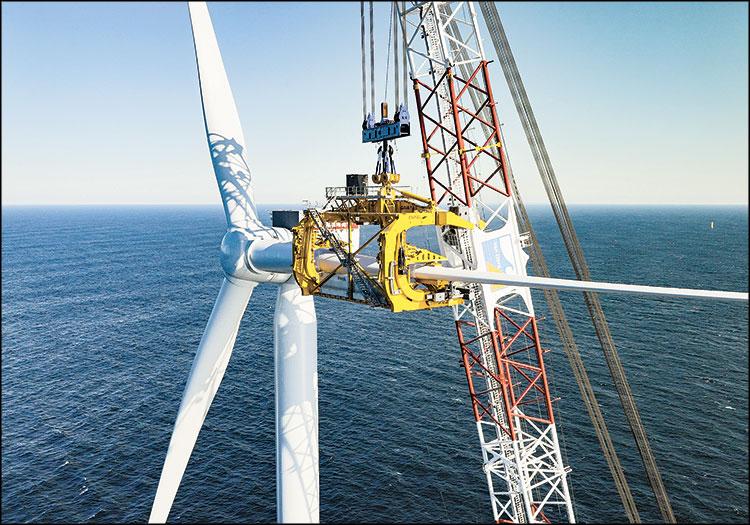The nascent offshore wind industry has proven its economic benefit — to union workers, businesses comprising every link in the supply chain, all the way down to the delis, gas stations, and restaurants surrounding such projects, a panel of professionals agreed during a round-table discussion last Thursday that was part of a weeklong action by more than a dozen offshore wind groups across the Eastern Seaboard.
Adrienne Esposito, executive director of Citizens Campaign for the Environment, and Julia Damiano, offshore wind campaign manager with the New York League of Conservation Voters, moderated a discussion among representatives of the industry including labor and training centers.
The South Fork Wind farm, the nation’s first commercial-scale offshore wind farm, has been operating for more than a year. “It’s actually performing above expectations, as far as energy output is concerned,” Ms. Esposito said. The benthic region at the ocean’s bottom, she said, “has completely recovered and has a wide variety of fish and shellfish that have returned to that area. . . . The environment is thriving, and it’s producing enough electricity for 70,000 homes on Long Island.”
Two significantly larger wind farms — Sunrise Wind and the Empire Wind — are under construction despite a federal government hostile to offshore wind and favorable to fossil fuel-derived energy.
The economic impact of “those massive construction entities” and the “windustry” that has been created in New York State is sizable, panelists said. Offshore wind “has expanded our portfolio,” said Rosalie Drago, vice president of external affairs and strategic engagement at the Haugland Group, speaking of “400 of your neighbors,” all union members, who went from the South Fork Wind to the Sunrise Wind projects, and 840 local businesses, 98 percent of them within a 20-mile radius of the projects, benefiting as subcontractors and vendors. “It’s expanded our ability to hire and retain workers,” she said, “and the 800 businesses that we’ve spent money with have grown as a result.”
“When we build in the utility sector,” Ryan Stanton, executive director of the Long Island Federation of Labor, said, “we’re creating union jobs and we’re investing money to make sure that we have the infrastructure to support our region.” Those workers “are spending money at the restaurants near the Port of Coeymans,” on the Hudson River, and “are at the gas station in East Hampton when they’re working on South Fork Wind.”
Eleven unions are working on Sunrise Wind, Ms. Drago said. “These are not foreign workers. These are our neighbors working on the jobs.” In fact, she said, “overseas companies are asking for local labor now to come work on their project.” Offshore wind is now a career, she said. “If you want a local career, if you want to be at sea, if you want to go travel, it’s got all those pieces to it.”
Ms. Esposito asked how the next generation will be prepared to work in this new industry. The Institute for Workforce Advancement, Phil Rugile, its president, said, is offering a five-day energy program under a New York Power Authority grant “that introduces people to all the various components of the renewable energy markets — and that’s a small piece of what’s actually going on.” The National Offshore Wind Training Center, on the campus of Suffolk Community College in Brentwood, certifies workers to work offshore, and Kingsborough Community College in Brooklyn offers a Bridges to Offshore Wind program. The New York State Energy Research and Development Authority “has a very good website on all the training programs available throughout the state,” he said.
In the Bronx, “we have SUNY Maritime, which is part of the state school system that is producing a huge amount of work force. They’re doing certification training for all aspects of the maritime operations.” The entire crew of the 262-foot ECO Liberty, a service operations vessel for the Empire Wind project, comes from SUNY Maritime College, Mr. Rugile said.
Ms. Drago recommended that those who will soon graduate from high school seek internships in the industry. “You can certainly go into an apprenticeship for a trade. . . . If you’re on the college-first path, you can go into construction management, engineering, software development.”
NYSERDA’s website, Mr. Stanton said, includes a portal for businesses “interested in plugging into this industry. Just search those businesses and see who might already be operating, and then pursue an internship there.” An effort called Opportunities on Long Island, he said, “is a pre-apprenticeship program that recruits from communities across the region, that provides a direct-entry pathway into the building and construction trade.”
“We have seen investment sustain and support increased recruitment into apprenticeship programs,” he said, but lamented that “Americans’ politics have been hijacked” and people lose sight of the fact that “our economics and our politics are unequivocally connected. The decision to invest in the offshore wind industry that was made in certain states to create that market and that pipeline of projects that supports those apprenticeship programs doesn’t just benefit those states. We have substations that are American-manufactured substations supporting projects like South Work Wind. That happened because we in America decided to invest in ourselves.”
The ECO Liberty was also built domestically, he said. In this political climate, “Folks don’t get to realize or appreciate, the money’s getting spent in red states and blue states. It’s supporting Republicans and Democrats, conservatives and liberals. When we talk about an economic impact and investing public dollars and shoring up American energy independence, that’s what that means.”
The nation’s infrastructure is aging, Ms. Drago said. “We have an incredible increased demand for power, and a rise in severe weather situations. So there’s no question that we need a strategic, balanced, and diverse power portfolio, so wind has to be in. . . . That infrastructure has to be built at the same time we’re building all of these power-supply sources. So we have to strengthen the current grid all at the same time, which means jobs and transferable skills, but . . . we can’t lose momentum on new innovative ways to produce power.”




